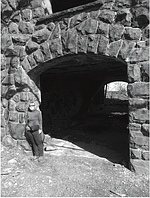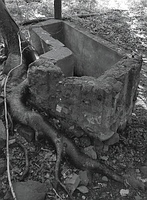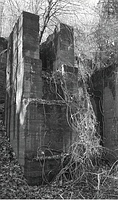Ghosts of the Palisades
My wife Dallas and I are standing beneath an old stone archway that we encountered during a Sunday walk along the Long Path, the hiking trail that runs along the top edge of the cliff of the majestic Hudson Palisades. The arch, and the grey stone foundation of which it is a part, are incongruous in this strip of wild land. Yet they have become so shaded by tall trees and so shroud with bushes and vines, that in summer, when the vegetation is lush, one might walk past them without noticing. Oddly, some ornamental plants of a bygone era survive. Forsythia, yew and ivy hint at a time when this spot was within civilization.
I was awed when I first encountered these ruins, on a hike many years ago, and a little melancholy, too, reflecting on past times, now vanished. Today, I am trying to imagine the Roaring Twenties, for this is what is left of Cliffdale Manor, a mansion built in 1911 by a businessman named Zabriskie (about whom I know nothing), which attained its glory during that decade. In my mind’s eye, a Studebaker Roadster pulls up to this archway and discharges a man in elegant peaky blinders and a woman in a glamorous flapper dress and cloche hat, ready to party within. That’s all gone, now. Nature has reclaimed the land.
The woods atop of the Palisades hold many such reminders of times long gone. A few, like the Revolutionary War batteries at Fort Lee, are lovingly cared for, but most have been left to slowly fade. And this is fitting, for they are but ordinary structures that suited the needs of their time. Now they are ghostly places, frequented only by dear and foxes, swallows, crows and owls — and the occasional hiker. Although their story might be recorded in old public records, or as a paragraph in a book on Hudson Valley history, I, like most hikers, can but guess at their significance. Their value is in their mystery, or at least that is their value to me. They inspire me to ghost stories.
In Tallman Park, often I walk by the foundation of a small, now-vanished house, located by a turn in an unblazed trail. The foundation is made partly of stone, partly of brick. The house’s most notable features are the concrete cistern built into its foundation, which is about the size of a bathtub, and nearby, a shallow, stone-lined well. The cistern and well remind me how precious is water, especially in the era before pipeline networks and water companies — but today, too. The Hudson Valley is prone to late summer—early fall droughts, when the streams atop the Palisades run dry and the leaves of trees wither. I have hiked during such dry times, carefully husbanding my water supply, though my throat be dry, and eagerly searching for the next spring. Did inhabitants of this little house ever worry that they would run out? How did they plan to cope?
Any of us who have walked around Rockland Lake and encountered the myriad of ducks, Canada Geese, sea gulls and swans that live in it, might question the sanity of someone who drank its waters. Yet, its water — or rather its winter ice — was much sought after, mined on an industrial scale, and shipped to folk in New York City. In all fairness, I suppose that the ice was used mostly as a refrigerant in people’s iceboxes — I can still remember my grandmother speaking of her icebox — and not for cubes in someone’s martini.
In any case, the logistical problem of getting the ice from the lake, over the ridge of the Palisades, to barges waiting on the Hudson River below, led to the construction of the singularly curious gravity railway. It is a sequence of stone ramps, some twenty feet high, some composed of stones three feet across, that were used to lower cartloads of ice down the hillside. Though badly eroded now, these ramps still convey the sense of industry, of getting the work done. Still, I wonder about the teams of workers who, I suppose, were mostly boys and young men, who cut the ice from the lake and loaded the carts. The winter is wonderland for hikers like Dallas and me. We love crunch of snow under our snowshoes and the low winter sun lighting up trees, rocks and lake. But I hate to have cold, wet hands. How did these workers find winter? Did they notice the beauty of the snow and ice or where they consumed by their hard work?
Finally, I would mention the crusher. I love the crusher, because it looks like the battlements of an old castle, nestled up against the hillside, below the Haverstraw Trail on Hook Mountain. Its shape, with two towers separated by a lower structure, suggests a gateway — perhaps the entrance into some hidden realm beneath the mountain. Around it grow multiflora rose bushes and wineberry vines. Their blossoms decorate the surrounding plaza in spring, but their thorns restrict access to a few well-trod paths. Old and very heavy machinery – gears, shafts and even a ship’s propeller – are scatted about. The crusher looks onto a decrepit dock of tilting concrete slabs, across which one must tread carefully to reach the edge of the Hudson River. That I hate the crusher, too, goes without saying, because what it crushed was the rock of the Palisades, reducing it to aggregate for the concrete buildings of Manhattan. Had its work — and the work of its siblings up and down river — been complete, the Palisades would be no more. The quarry cut in the cliff above attests to its voraciousness. But rather than despise the folk who operated the crusher, I sadly consider that they somehow missed seeing the beautiful things around them. And like in any good ghost story, a soft voice is asking, “And what beauty are you, Bill Menke, missing now?” Ghosts are always so eager to lay on a guilt trip. But I am not one prone to excessive brooding over such matters. The sun is shining brightly. A patch of wild mint growing along the edge of the Hudson is piquing my interest. Who would have thought that mint was so salt-tolerant?
Acknowledgement. I am indebted to my late friend Ernest Quick for both the title of this essay and the drive to complete it. Five years ago, even though his condition was becoming advanced, Ernie and I had a wonderful brainstorming session, scoping out how such an essay might work. Although circumstances in both our lives caused us to put off working on it, I am glad to have been able to put something on paper, which although not a joint work, still captures something of that conversation.
Bill Menke is a professor of Earth & Environmental Science at Columbia University, an advocate for open spaces and the preservation of Nature, and an avid hiker and kayaker. Photos taken by Bill Menke during his many hikes along the Hudson Palisades can be found by Googling; Bill Menke's Slides.





